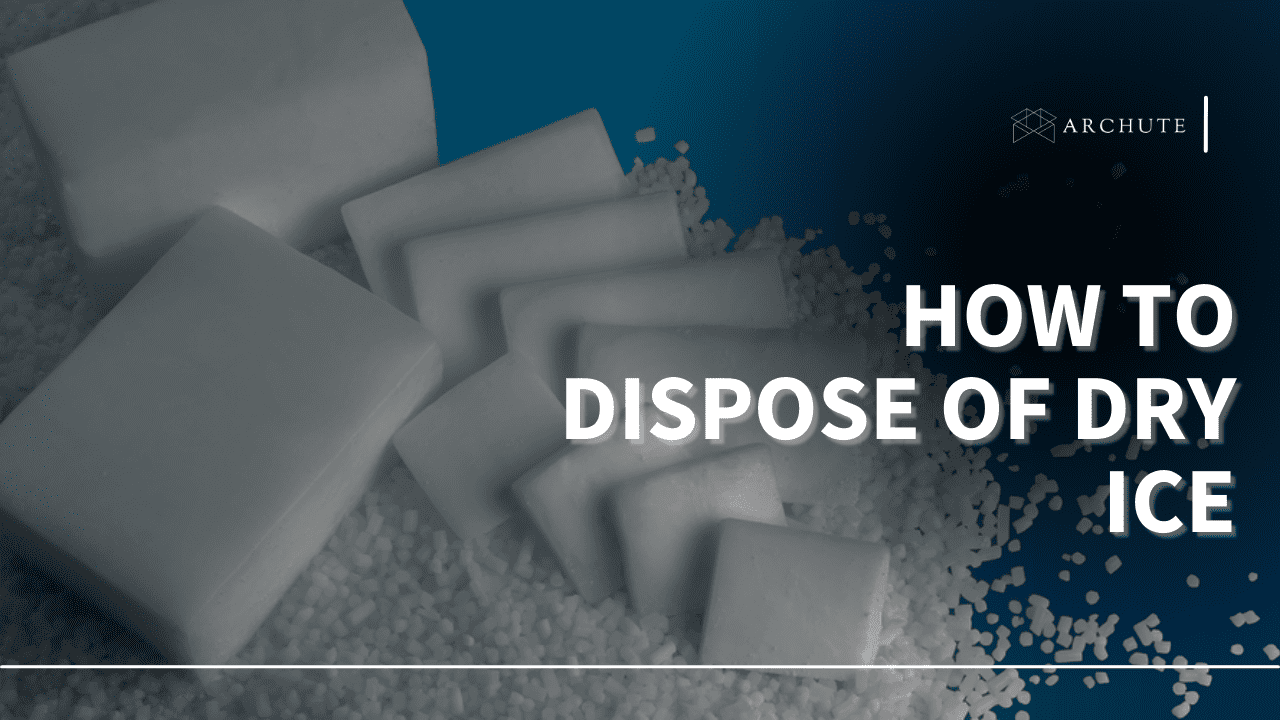Over the past couple of years, the use of dry ice has become popular. The only problem that most people face is how to dispose of dry ice safely and effectively. However, there are a variety of ways how to do it.
In addition to disposing of dry ice properly, there are multiple things you need to take care of to avoid any undesirable incidents. This article will discuss the safety precautions and the safe ways to handle and dispose of dry ice. Let’s dive in!
What Is Dry Ice?
Dry ice is solidified carbon dioxide. When carbon dioxide is exposed to temperatures below negative 109.2 degrees Fahrenheit or the earth’s atmospheric pressure, it creates dry ice. Temperatures below 109.2 degrees will cause the dry ice to sublimate or evaporate.
Dry ice is readily available at grocery stores and home centers. They come in blocks, pellets, or flakes and are mainly used to transport temperature-sensitive items, conduct scientific experiments and make condensation effects. Because of the extremely extreme cold and temperatures the dry ice requires, it requires extreme care.
Now that you have an idea of what dry ice is let’s dive in and see how to dispose of dry ice safely and effectively.
How To Dispose Of Dry Ice Safely
Before disposal of dry ice, you should first know that Dry ice requires extreme care when handling it. Remember, touching the dry ice with bare hands can cause mild to severe frostbite, contact burns, or other injuries.
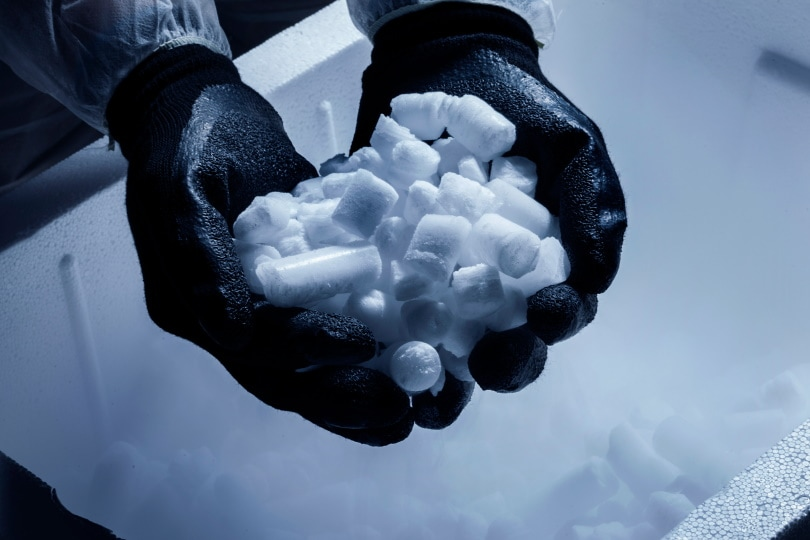
Image Credits: Housegrail.com
It is best to dispose of dry ice to let it turn gaseous in a well-ventilated area. Next, we will look at the proper disposal method you could use to get rid of dry ice safely and effectively.
STEP 1: Select The Right Place And Time
The first set is to choose a space with open windows and proper ventilation. You should pick a place that children or pets can not access. You could choose to do it in your backyard or fire escape. Also, you will need to choose a proper time to dispose of the ice. The best it would be on an uncloudy day.
STEP 2: Wear The Right Gear For Disposal
It is also important that you wear the right gear to start the process. First, you must wear insulated gloves meant for handling dry ice, like oven mitts or winter gloves.
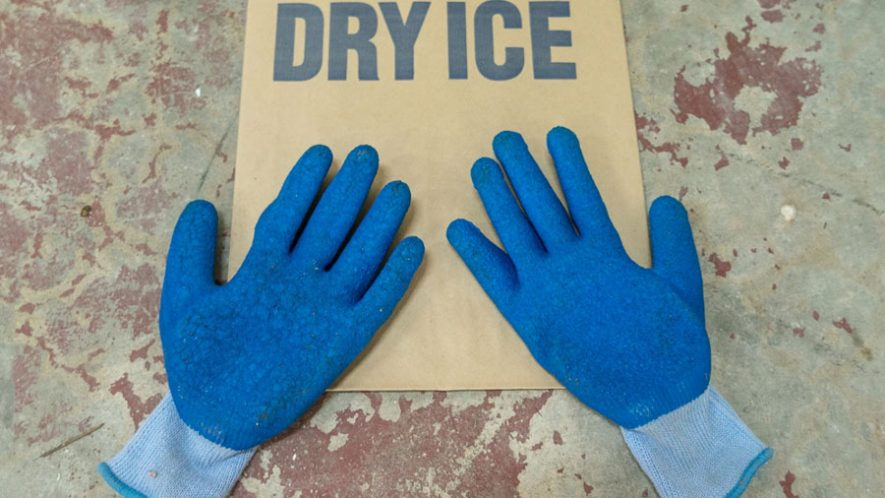
Image Credits: Dryicecambodia.com
Then you should wear a long sleeve shirt, safety glasses, and closed-toe shoes; this way, your bare skin is properly protected from direct contact with the dry ice.
Step 3: Letting Dry Ice Sublimate
When you have the insulated gloves on, place the dry ice in an open and well-ventilated space to sublimate or evaporate fully. For example, you could place the dry ice on a flat surface or solid surface like Styrofoam or hard plastic to avoid causing damage to the floor. As mentioned above, when dry ice is kept at a temperature above negative 109 degrees Fahrenheit, it transforms from a solid to a gaseous form.
This evaporation process can take up to a day for five to ten pounds of carbon dioxide to be released from dry ice. You must avoid staying in the area to prevent exposing yourself to too much carbon dioxide vapor alone, which could cause nausea, vomiting, headaches, or difficulty breathing.
Step 4: Let It Sit For Up To A Day
Depending on the amount of dry ice you are disposing of, it is important that you let it sit until it is completely reverted into gas. Then, let the leftover dry ice sit in the well-ventilated area for at least a day, and you could check on it to see if everything is okay.
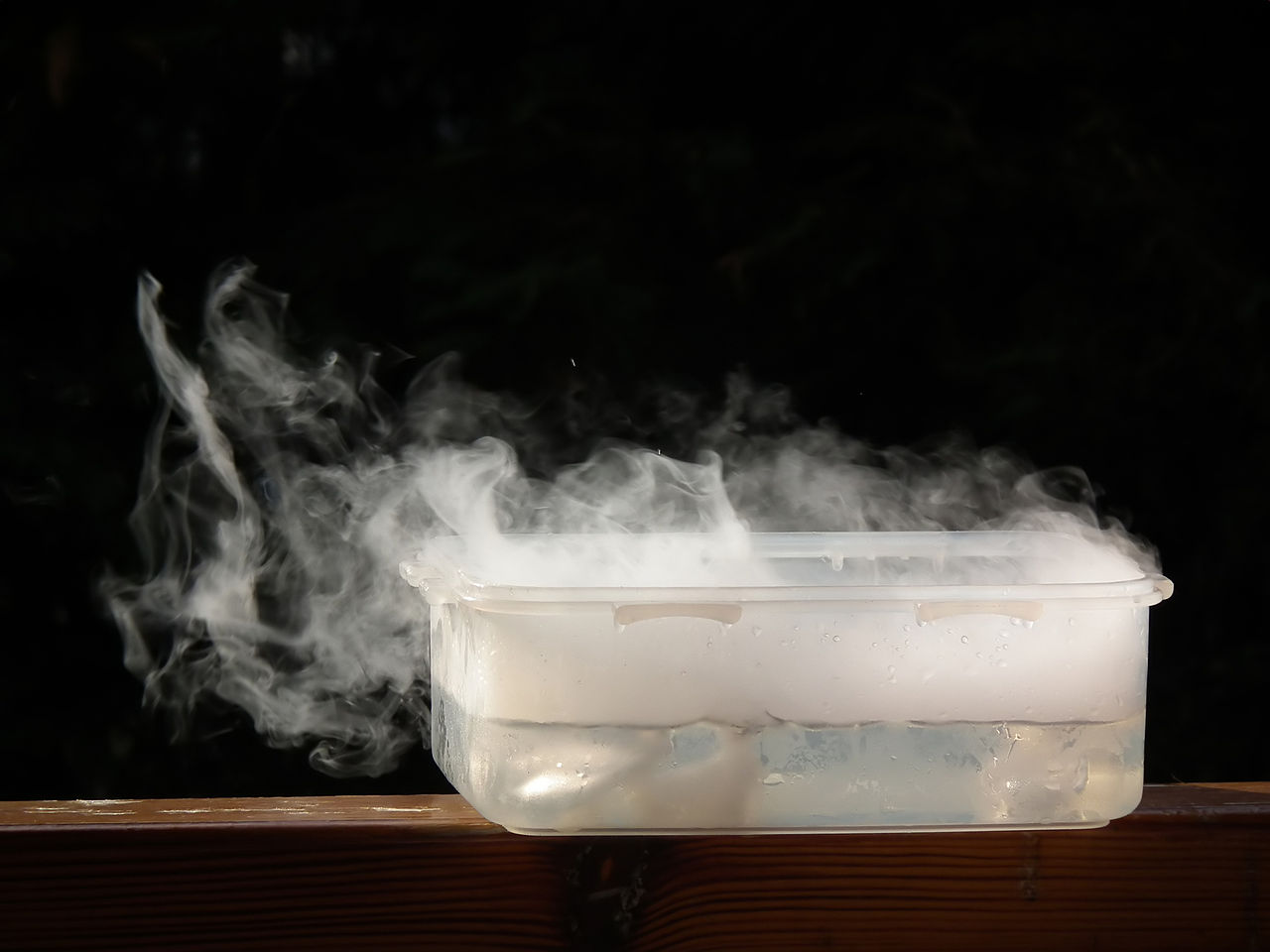
Image Credits: Usgs.gov
If you have too much dry ice, you need to dispose of it and do not have enough time; you could speed up the process. For example, you can break the dry ice into smaller pieces or pour warm water or hot water on the dry ice. Ensure when doing this, your insulated gloves and protective glasses are on. Generally, the block dry ice form will take longer than pellets, ice tongs, or flakes.
Step 5: Dispose Of The Thing Used Correctly
Once you have completed the process or the dry ice has fully evaporated or transformed into carbon dioxide gas, it is now time to dispose of the equipment you used. The airtight hard plastic container used to store the dry ice in the fridge, the protective gear, and the flat surface used to dispose of dry ice should be disposed of correctly too.
First, you should remove them and set them aside, ideally in a plastic bag. Then it would help to place them in a trash can that accepts hazardous waste products or take them to a local waste collection site. However, you mustn’t know how to dispose of dry ice while in poor ventilation, like a building’s garbage chute bottom, garbage shoot, or trash cans.
Special Precautions For Handling Dry Ice
As mentioned above, dry ice can be dangerous if handled incorrectly or carelessly.
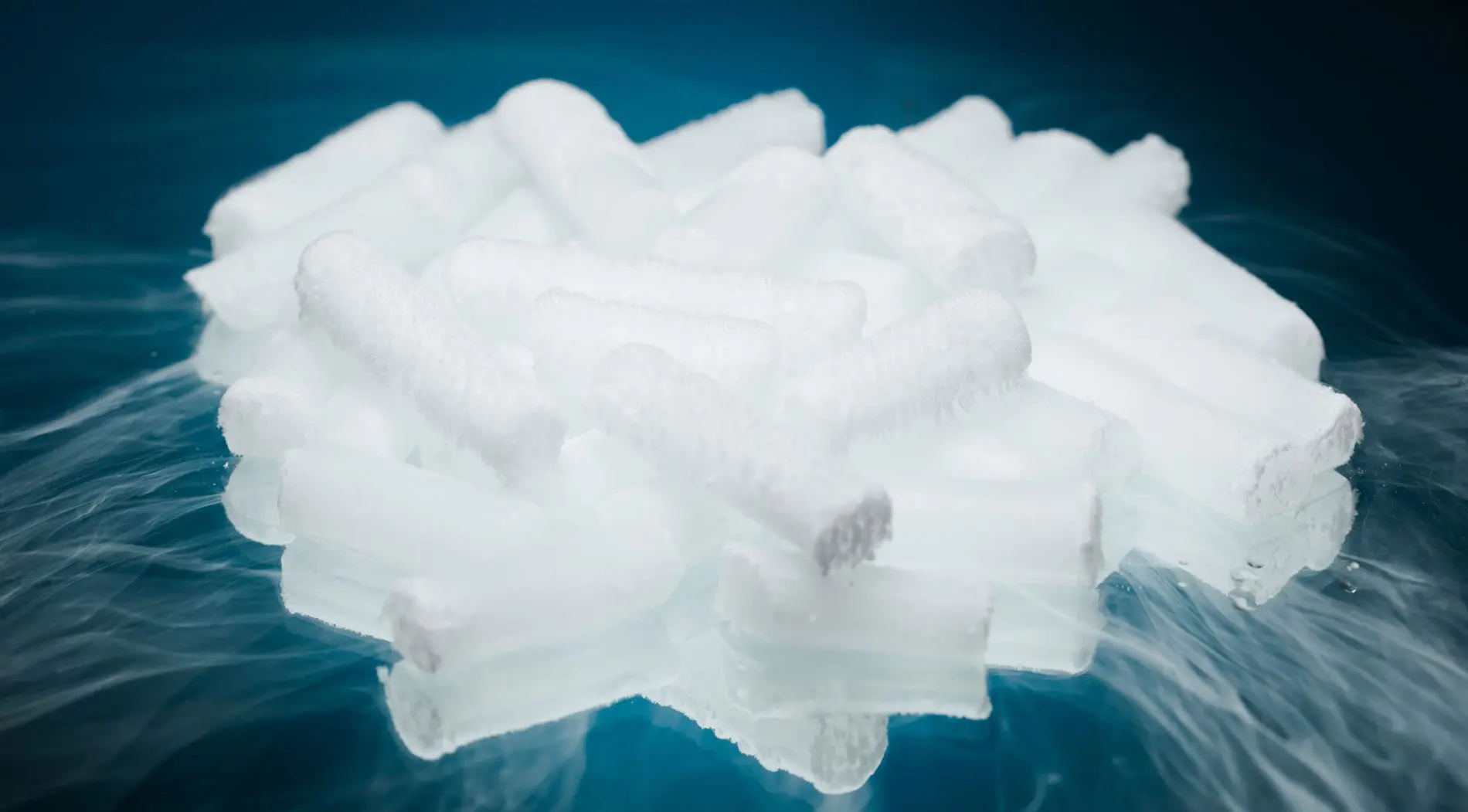
Image Credits: Vesselservicesinc.com
Consequently, it is essential to handle it with proper care. Here are some helpful tips on how to handle dry ice:
1. Dispose Of Dry Ice In Well-Venerated Areas
You should never leave dry ice in public areas. Remember, dry ice disposal in areas like public areas or poor ventilation can create an oxygen-deficient atmosphere because of carbon dioxide gas buildup. Always dispose of dry ice in areas not accessible to the public, animals, and children.
Using dry ice in a walk-in freezer, cooler, or enclosed space is also very risky. A considerable amount of dry ice in a walk-in freezer or air cooler can build up a large amount of carbon dioxide. This can conceivably cause an explosion that can be fatal to someone entering that space. Also, you should never leave the dry ice unattended.
2. Don’t Touch Dry Ice With Your Bare Skin
You should never touch dry ice with bare skin when handling ice burns or disposing of dry ice. Therefore, you must wear protective gear to avoid it. Also, remember that touching dry ice may cause frostbite or burns. So to safely dispose of the ice, you will need proper gear before you even start.
3. Don’t Dump Dry Ice In The Garbage Disposal
You must avoid disposing of dry ice in trash cans, sewers, or garbage chutes. The dry ice disposal should be conducted in a well-venerated and well-ventilated space to avoid the buildup of carbon dioxide vapor which could lead to an explosion.
4. Do Not Dump Dry Ice In A Sink Or Toilet
Even though we mentioned you could use hot water to fasten the dry ice disposal process, it should not be done in a sink. The extreme cold temperatures from the dry ice could cause damage to the kitchen sink or toilet parts.
5. Store The Dry Ice Correctly
You should not store dry ice in a glass or an airtight container. You should store the dry ice in containers that allow it to lay off carbon dioxide gas. You must use containers meant to be used to store dry ice. Unlike regular ice, you should never place dry ice on a tile or laminate countertop.
Storing the dry ice in a freezer or cooler is not a good idea because it can turn the fridge off. The best option is to store the dry ice in an insulated or Styrofoam cooler. Also, the Styrofoam cooler should be placed in a place or a not frequently used room.
6. Transport Dry Ice In A Vehicle With Adequate Ventilation
If you are transporting dry ice, keep it in the truck and open one or more windows. The carbon dioxide gas emitted from the dry ice evaporates slowly and could easily fill a small passenger’s car or enclosed space. This may cause you to feel disoriented or file, putting you at a high risk of causing an accident.
7. Purchasing It Long Before Use
If you want the dry ice to last longer, you should not purchase it long before the intended time of use. The dry ice changes or turns from solid to gas pretty fast, so it will likely not last long if you buy it beforehand.
Regardless of how you store the dry ice, sublimate even though it will not be fully sublimated. For instance, if you want to use dry ice for Christmas, you can purchase it when the event starts.
What Are The Major Uses Of Dry Ice?
1. Food Industry
Mostly dry ice is used to freeze food or keep the food cooler for longer than regular ice. The carbon dioxide in the ice gives it the ability to flash-freeze foods and is frequently used as a freezer back up. Mostly the ice is used in commercial kitchens, supermarkets, and restaurants.
The dry ice will help remove bacteria and molds in places that handle food regularly. This way, you can prevent allergic reactions or foodborne diseases. However, it is necessary to know that it can be dangerous to use dry ice, even though it is a standard practice in the food industry.
2. Oil Industry
Dry ice is also used in oil industries for cleaning the bottoms of tanks. The ice is mixed with a certain chemical and then stirred in a tank base to remove pollutants. In the process, the oil is isolated from the water, which saves a lot of oil.
3. Medical Purposes
Dry ice is majorly used in the medical industry. In some cases, carbon dioxide is used as an alternative to liquid nitrogen, which is necessary for surgeries. Again, the ice is used to transport biological samples, which need further testing. Also, it is used to freeze bone marrow while shipping.
4. Freeze Branding
Freeze branding is a way of visibly and perpetually identifying animals. It can be a very painful but still very humane process. Freeze Branding is mostly done on animals like dogs, horses, and cattle. Mostly this ice is used to make the branding process less painful for the animals since the branding process is very painful.
Frequently Asked Questions on How To Dispose Of Dry Ice
1. Can you pour melted dry ice down the sink?
It could be that you have some leftover dry ice after an occasion and wonder how to dispose of it. The first thing that comes to mind is to flush it down the toilet or pour it down the sink, thinking it will melt immediately since it is ice. However, this is not the case; you should not even think along those lines.
Dry ice does not melt but instead freezes the water in the pipes. When all water freezes, it will expand and lead to burst pipes and cause huge amounts of damage. If you accidentally drop dry ice in your sink, pour hot water over it immediately.
2. Can I melt dry ice with water?
When you add warm water to a tightly sealed container or dry ice container, a dense white fog will immediately be generated. The white fog is composed of an aerosol of tiny water droplets, just like how a mist or fog creates in the open nature. The dense white fog results from the very cold, dry ice subliming from its solid state to the gaseous state.
3. How long does dry ice take to melt?
Dry ice is frozen carbon dioxide; apart from keeping foods cold or frozen, it can last for a very long time. How long it can stay without melting depends on two factors which are how well it is stored and the size of the ice block. To put it into perspective, an average five-pound brick in a cooler will take 18 to 24 hours.
When placed outdoors, in warm or hot water, the same amount of ice will stay 3 to 5 hours to melt (sublime), and when put in a liquid, the same amount of ice cube will take 15 to 45 minutes to melt. However, it is important to remember that solid carbon dioxide melts when you put it at 5.11 Atmospheres and -56.4 degrees centigrade. You might not witness how too much carbon dioxide in dry ice melts when you keep it in a beaker at room temperature and atmospheric pressure.
4. What happens if you flush dry ice?
Dry ice is solid Carbon (IV) Oxide. It is so extremely cold that it will end up freezing running water instead of it melting. When this happens, it can burst your pipes and cause too much damage. When you accidentally flush dry ice down the drain, do not panic; follow it up with hot water. Failing to pour hot water immediately could lead to more damage to your plumbing system and even the walls.
5. What to do with dry ice
Dry ice can cause Carbon (IV) Oxide to accumulate in a room hence building up pressure; you should not dispose of it in a sewer, garbage chute, or garbage disposal. Instead of putting dry ice, let it melt and turn into a gas state in a well-ventilated environment.
6. What’s the fasted way of destroying dry ice?
The best and fastest way to get rid of dry ice is by placing it in a well-ventilated air-tight environment at room temperature and letting it sublimate. Refrain from disposing of fry ice in a trash can or any of the places mentioned in (5). Do not dispose of it in a waste can or chemical container.
7. Can you dissolve dry ice?
Water transfers heat more effectively than air. Hence, when you put dry ice in hot water, it will sublimate into gas much faster. If you want to dispose of it faster, put the dry ice in a pot of boiling water on the stove.
Conclusion on How To Dispose Of Dry Ice
Dry ice is not like your regular ice and must be handled and disposed of differently. When storing dry ice, ensure you use an insulated or Styrofoam container. And because of the potential hazards of disposing of dry ice, you can not dump the garbage cans or flash them in the toilets.
Now that we fully understand how to dispose of dry ice, it is essential that you let it evaporate and place leave dry ice out in well-ventilated areas. Then, you need to dispose of any items in direct contact with the dry ice in the hazardous waste bins.

